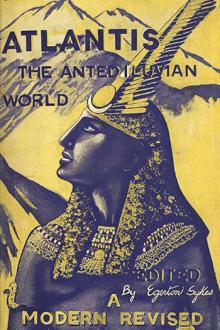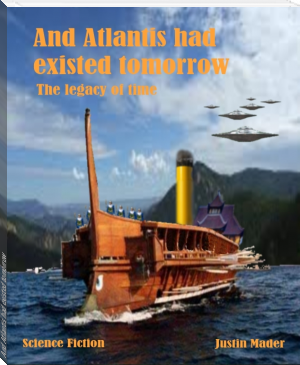Atlantis: The Antedeluvian World by Ignatius Donnelly (thriller novels to read .TXT) 📕

- Author: Ignatius Donnelly
- Performer: -
Book online «Atlantis: The Antedeluvian World by Ignatius Donnelly (thriller novels to read .TXT) 📕». Author Ignatius Donnelly
From this account it appears that the rain of water and mud came from a boiling lake on the mountains; it must have risen to a great height, “like a water-spout,” and then fallen in showers over the face of the country. We are reminded, in this Boiling Lake of Dominica, of the Welsh legend of the eruption of the Llyn-llion, “the Lake of Waves,” which “inundated the whole country.” On the top of a mountain in the county of Kerry, Ireland, called Mangerton, there is a deep lake known as Poulle-i-feron, which signifies Hell-hole; it frequently overflows, and rolls down the mountain in frightful torrents. On Slieve-donart, in the territory of Mourne, in the county of Down, Ireland, a lake occupies the mountain-top, and its overflowings help to form rivers.
If we suppose the destruction of Atlantis to have been, in like manner, accompanied by a tremendous outpour of water from one or more of its volcanoes, thrown to a great height, and deluging the land, we can understand the description in the Chaldean legend of “the terrible water-spout,” which even “the gods grew afraid of,” and which “rose to the sky,” and which seems to have been one of the chief causes, together with the earthquake, of the destruction of the country. And in this view we are confirmed by the Aramæan legend of the Deluge, probably derived at an earlier age from the Chaldean tradition. In it we are told, “All on a sudden enormous volumes of water issued from the earth, and rains of extraordinary abundance began to fall; the rivers left their beds, and the ocean overflowed its banks.” The disturbance in Dominica duplicates this description exactly: “In a moment” the water and mud burst from the mountains, “the floodgates of heaven were opened,” and “the river overflowed its banks.”
And here, again, we are reminded of the expression in Genesis, “the same day were all the fountains of the great deep broken up” (chap. vii., 11). That this does not refer to the rain is clear from the manner in which it is stated: “The same day were all the fountains of the great deep broken up, and the windows of heaven were opened. And the rain was upon the earth,” etc. And when the work of destruction is finished, we are told “the fountains also of the deep and the windows of heaven were stopped.” This is a reminiscence by an inland people, living where such tremendous volcanic disturbances were nearly unknown, of “the terrible water-spout which “rose to the sky,” of the Chaldean legend, and of “the enormous volumes of water issuing from the earth” of the Aramæan tradition. The Hindoo legend of the Flood speaks of “the marine god Hayagriva, who dwelt in the abyss,” who produced the cataclysm. This is doubtless “the archangel of the abyss” spoken of in the Chaldean tradition.
The Mountains of the North.—We have in Plato the following reference to the mountains of Atlantis:
“The whole country was described as being very lofty and precipitous on the side of the sea. . . . The whole region of the island lies toward the south, and is sheltered from the north. . . . The surrounding mountains exceeded all that are to be seen now anywhere.”
These mountains were the present Azores. One has but to contemplate their present elevation, and remember the depth to which they descend in the ocean, to realize their tremendous altitude and the correctness of the description given by Plato.
In the Hindoo legend we find the fish-god, who represents Poseidon, father of Atlantis, helping Mann. over “the Mountain of the North.” In the Chaldean legend Khasisatra’s vessel is stopped by “the Mountain of Nizir” until the sea goes down.
The Mud which Stopped Navigation.—We are told by Plato, “Atlantis disappeared beneath the sea, and then that sea became inaccessible, so that navigation on it ceased, on account of the quantity of mud which the ingulfed island left in its place.” This is one of the points of Plato’s story which provoked the incredulity and ridicule of the ancient, and even of the modern, world. We find in the Chaldean legend something of the same kind: Khasisatra says, “I looked at the sea attentively, observing, and the whole of humanity had returned to mud.”
In the “Popol Vuh” we are told that a “resinous thickness descended from heaven,” even as in Dominica the rain was full of “thick gray mud,”
accompanied by an “overpowering smell of sulphur.”
The explorations of the ship Challenger show that the whole of the submerged ridge of which Atlantis is a part is to this day thickly covered with volcanic débris.
We have but to remember the cities of Pompeii and Herculaneum, which were covered with such a mass of volcanic ashes from the eruption of A.D. 79 that for seventeen centuries they remained buried at a depth of from fifteen to thirty feet; a new population lived and labored above them; an aqueduct was constructed over their heads; and it was only when a farmer, in digging for a well, penetrated the roof of a house, that they were once more brought to the light of day and the knowledge of mankind.
We have seen that, in 1783, the volcanic eruption in Iceland covered the sea with pumice for a distance of one hundred and fifty miles, “and ships were considerably impeded in their course.”
The eruption in the island of Sumbawa, in April, 1815, threw out such masses of ashes as to darken the air. “The floating cinders to the west of Sumatra formed, on the 12th of April, a mass two feet thick and several miles in extent, through which ships with difficulty forced their way.”
It thus appears that the very statement of Plato which has provoked the ridicule of scholars is in itself one of the corroborating features of his story. It is probable that the ships of the Atlanteans, when they returned after the tempest to look for their country, found the sea impassable from the masses of volcanic ashes and pumice. They returned terrified to the shores of Europe; and the shock inflicted by the destruction of Atlantis upon the civilization of the world probably led to one of those retrograde periods in the history of our race in which they lost all intercourse with the Western continent.
The Preservation of a Record.—There is a singular coincidence in the stories of the Deluge in another particular.
The legends of the Phœnicians, preserved by Sanchoniathon, tell us that Taautos, or Taut, was the inventor of the alphabet and of the art of writing.
Now, we find in the Egyptian legends a passage of Manetho, in which Thoth (or Hermes Trismegistus), before the Deluge, inscribed on stelæ, or tablets, in hieroglyphics, or sacred characters, the principles of all knowledge. After the Deluge the second Thoth translated the contents of these stelæ into the vulgar tongue.
Josephus tells us that “The patriarch Seth, in order that wisdom and astronomical knowledge should not perish, erected, in prevision of the double destruction by fire and water predicted by Adam, two columns, one of brick, the other of stone, on which this knowledge was engraved, and which existed in the Siriadic country.”
In the Chaldean legends the god Ea ordered Khasisatra to inscribe the divine learning, and the principles of all sciences, on tables of terra-cotta, and bury them, before the Deluge, “in the City of the Sun at Sippara.”
Berosus, in his version of the Chaldean flood, says: “The deity, Chronos, appeared to him (Xisuthros) in a vision, and warned him that, upon the 15th day of the month Dœsius, there would be a flood by which mankind would be destroyed. He therefore enjoined him to write a history of the beginning, procedure, and conclusion of all things, and to bury it in the City of the Sun at Sippara, and to build a vessel,”
etc.
The Hindoo Bhâgavata-Purâna tells us that the fish-god, who warned Satyravata of the coming of the Flood, directed him to place the sacred Scriptures in a safe place, “in order to preserve them from Hayagriva, a marine horse dwelling in the abyss.”
Are we to find the original of these legends in the following passage from Plato’s history of Atlantis?
“Now, the relations of their governments to one another were regulated by the injunctions of Poseidon, as the law had handed them down. These were inscribed by the first then on a column of orichalcum, which was situated in the middle of the island, at the Temple of Poseidon, whither the people were gathered together. . . . They received and gave judgments, and at daybreak they wrote down their sentences on a golden tablet, and deposited them as memorials with their robes. There were many special laws which the several kings had inscribed about the temples.” (Critias, p. 120.)
A Succession of Disasters.—The Central American books, translated by De Bourbourg, state that originally a part of the American continent extended far into the Atlantic Ocean. This tradition is strikingly confirmed by the explorations of the ship Challenger, which show that the “Dolphin’s Ridge” was connected with the shore of South America north of the mouth of the Amazon. The Central American books tell us that this region of the continent was destroyed by a succession of frightful convulsions, probably at long intervals apart; three of these catastrophes are constantly mentioned, and sometimes there is reference to one or two more.
“The land,” in these convulsions, “was shaken by frightful earthquakes, and the waves of the sea combined with volcanic fires to overwhelm and ingulf it. . . . Each convulsion swept away portions of the land until





Comments (0)